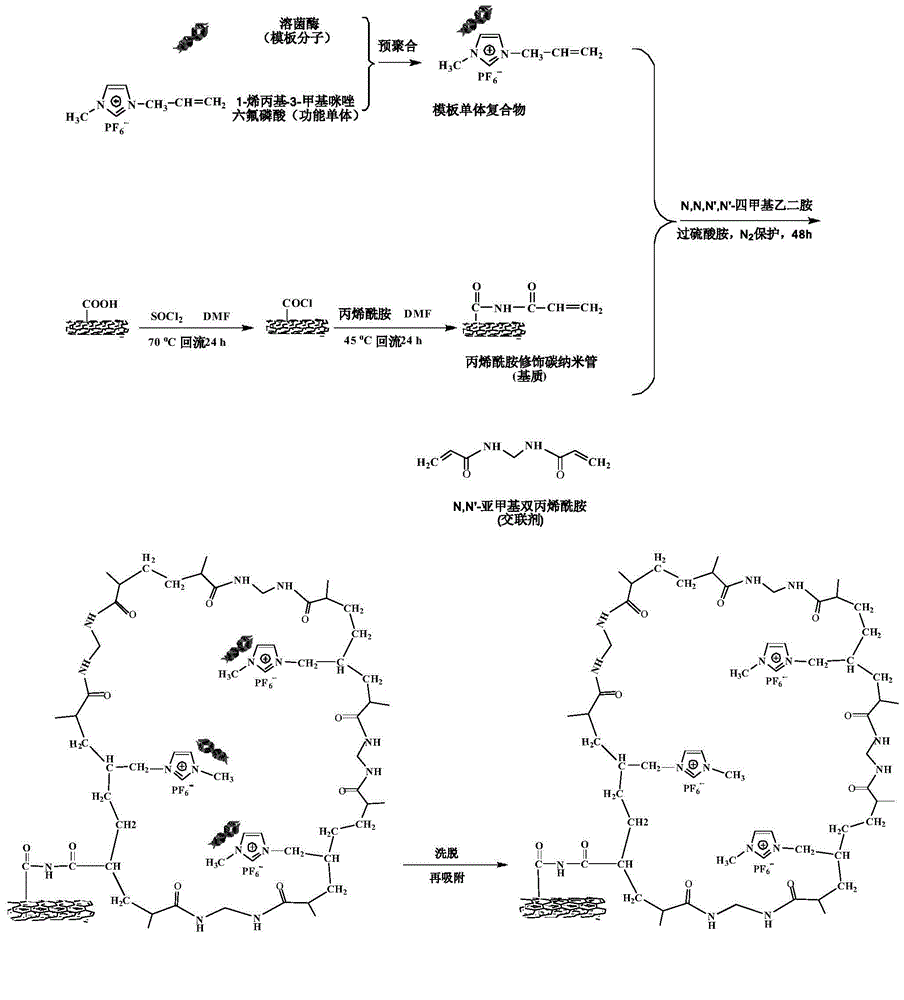Carbon nano tube surface lysozyme molecularly-imprinted polymer and preparation method thereof
A technology of carbon nanotubes and molecular imprinting, which is applied in the fields of chemistry and materials, can solve the problems of bulky protein, many binding sites, and unstable conformation, and achieve the effect of large specific surface area, rapid adsorption, and small steric hindrance
- Summary
- Abstract
- Description
- Claims
- Application Information
AI Technical Summary
Problems solved by technology
Method used
Image
Examples
Embodiment 1
[0049] Dissolve 18 mg of lysozyme in 30 mL of Tris-HCl buffer solution with pH 9, add 200 mg of 1-allyl-3-methylimidazolium hexafluorophosphate ionic liquid, stir magnetically for 2 hours at room temperature; add 30 mg of acrylamide to modify carbon nanotubes , ultrasonically disperse evenly, add 100mg N,N'-methylenebisacrylamide, deoxygenate with nitrogen for 15 minutes; add 40mg ammonium persulfate, 50μL N,N,N',N'-tetramethylethylenediamine, Continue nitrogen deoxygenation for 15 minutes, and then magnetically stir at room temperature for 48 hours under anaerobic conditions. The solid-liquid phases were separated, and the solid-phase product was washed 5 times with a Tris-HCl buffer solution of pH 9, then eluted with ultrapure water until no protein remained, and freeze-dried to obtain the molecularly imprinted polymer of lysozyme on the surface of carbon nanotubes. . The synthesis and elution methods of the blank molecularly imprinted polymer are the same, except that the ...
Embodiment 2
[0051] Dissolve 18 mg of lysozyme in 30 mL of Tris-HCl buffer solution with pH 9, add 300 mg of 1-allyl-3-methylimidazolium hexafluorophosphate ionic liquid, stir magnetically for 2 hours at room temperature; add 30 mg of acrylamide to modify carbon nanotubes , ultrasonically disperse evenly, add 100mg N,N'-methylenebisacrylamide, deoxygenate with nitrogen for 15 minutes; add 40mg ammonium persulfate, 50μL N,N,N',N'-tetramethylethylenediamine, Continue nitrogen deoxygenation for 15 minutes, and then magnetically stir at room temperature for 48 hours under anaerobic conditions. The solid-liquid phases were separated, and the solid-phase product was washed 5 times with a Tris-HCl buffer solution of pH 9, then eluted with ultrapure water until no protein remained, and freeze-dried to obtain the molecularly imprinted polymer of lysozyme on the surface of carbon nanotubes. . The synthesis and elution methods of the blank molecularly imprinted polymer are the same, except that the ...
Embodiment 3
[0053] Dissolve 18 mg of lysozyme in 30 mL of Tris-HCl buffer solution with pH 9, add 350 mg of 1-allyl-3-methylimidazolium hexafluorophosphate ionic liquid, stir magnetically for 2 hours at room temperature; add 30 mg of acrylamide to modify carbon nanotubes , ultrasonically disperse evenly, add 100mg N,N'-methylenebisacrylamide, deoxygenate with nitrogen for 15 minutes; add 40mg ammonium persulfate, 50μL N,N,N',N'-tetramethylethylenediamine, Continue nitrogen deoxygenation for 15 minutes, and then magnetically stir at room temperature for 48 hours under anaerobic conditions. The solid-liquid phases were separated, and the solid-phase product was washed 5 times with a Tris-HCl buffer solution of pH 9, then eluted with ultrapure water until no protein remained, and freeze-dried to obtain the molecularly imprinted polymer of lysozyme on the surface of carbon nanotubes. . The synthesis and elution methods of the blank molecularly imprinted polymer are the same, except that the ...
PUM
| Property | Measurement | Unit |
|---|---|---|
| diameter | aaaaa | aaaaa |
| length | aaaaa | aaaaa |
| specific surface area | aaaaa | aaaaa |
Abstract
Description
Claims
Application Information
 Login to View More
Login to View More - R&D
- Intellectual Property
- Life Sciences
- Materials
- Tech Scout
- Unparalleled Data Quality
- Higher Quality Content
- 60% Fewer Hallucinations
Browse by: Latest US Patents, China's latest patents, Technical Efficacy Thesaurus, Application Domain, Technology Topic, Popular Technical Reports.
© 2025 PatSnap. All rights reserved.Legal|Privacy policy|Modern Slavery Act Transparency Statement|Sitemap|About US| Contact US: help@patsnap.com



